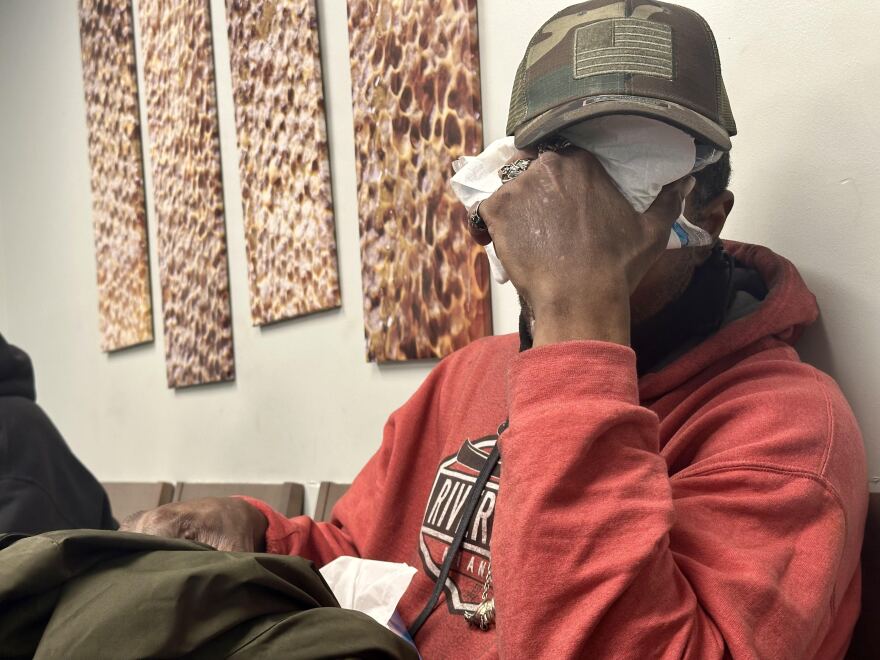If you don’t have money or a place to live, you might take your medical problems to the clinic on the second floor of a building at 8th and Paseo. It's called the KC Beehive.
In the small, crowded waiting room on one recent day, a man who wished to be known only as E. sat in grimy insulated coveralls with tears streaming down his cheeks.
“It’s an emergency. It’s like hurting really bad. I can not stand how bad it hurts,” said E. “It’s almost like being sprayed in the face with mace or pepper spray. It’s really uncomfortable, just every time you blink it’s like sand is rolling over your eyeballs.”

E. said toxic smoke from a camp fire had wrecked his vision. Normally he burns plastic, sometimes mixed with hand sanitizer, producing what he described as a “hot, clean fire.” But he has to make due, and smoke from old lumber saturated with chemicals, possibly arsenic, copper and chromium, got into his eyes.
“The plastic doesn’t hurt my eyes, it’s the wood. They're using just any kind of wood, and it’s been treated with chemicals and stuff like that. And then burning those chemicals and it gets in your eyes,” he said.
Across greater Kansas City, at least 3,000 people are living at least part-time on the streets. One of them was found dead a few blocks from the Beehive clinic last week. Whipsaw weather saps people’s energy and attacks their hands and feet.
“We have seen quite a bit of trench foot, particularly last week,” said KK Assmann, founder and CEO of Care Beyond the Boulevard, a group that provides free, mobile medical help.
The recent cold snap has seen high temperatures in the single digits and wind chills as low as 40 below zero.
“It rained and then it got really cold. So when that happens, people aren't taking off their shoes and socks because it's so cold. So then feet are just like in this wet environment,” which is what causes trench foot, according to Assmann.
Trench foot is painful, and it can lead to amputations. Assmann said it’s hitting more people now than at any time since she started helping homeless people eight years ago. But Assman said trench foot is soon to be overshadowed by frostbite.

“Oh, it hurts. It stings and feels like pins and needles. You can barely feel your toes and just, it hurts,” said Rodney Jenks, who was waiting to see a doctor about his toes.
Next to Jenks, a man who called himself Monkey cradled ragged, blackened hands.
“Cracked, chapped, hypersensitive. I mean, just today now I'm able to touch things without screaming out,” he said.
Assmann said her staff was just starting to see the worst of the frostbite: dead, blackened toes that would need to be amputated. There’s a lag between the onset of bitter cold and the rush of homeless people hobbling in on decaying feet. She expected that to peak over the next two weeks.

Meantime there’s another cold-related crisis.
“We’re seeing COVID and flu right now,” said Assmann. “We have people in congregate shelters, right? So you have people head to toe to head to toe sleeping to get warm, and they're also coughing and breathing and all of the other things.”
There’s a lot of coughing in the clinic waiting room.
“When I was sleeping, I woke up, scarry, sweat, I can’t breathe,” explained Yahia Alomari, who’s originally from Iraq.
COVID patients present a special problem. They can’t go directly back to homeless shelters and they need to be isolated. That means renting a hotel room for 10 nights. It’s expensive.
“You can't put them in hotels and not give them food. They don't have money to pay for food. They're supposed to be staying in. You can't put them in a hotel and then just forget about them for 10 days,” said Assmann. “One person in a hotel for 10 days with food and the hotel runs about a thousand dollars. And we are almost out of funds for that.”







